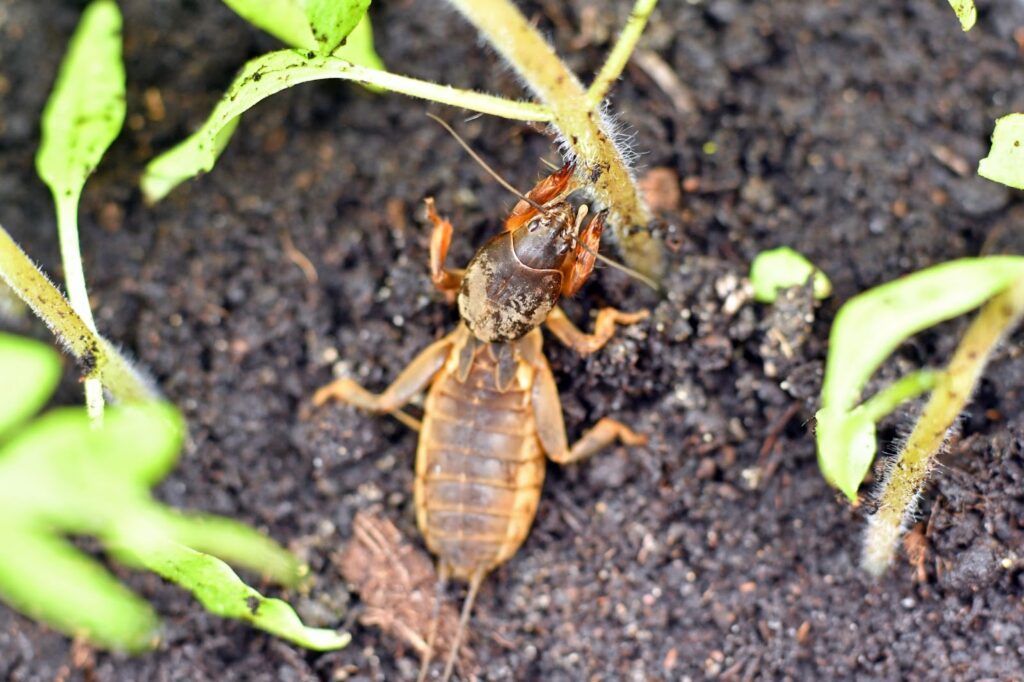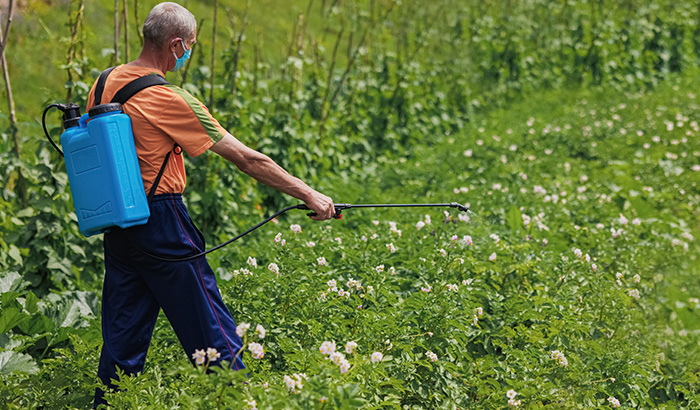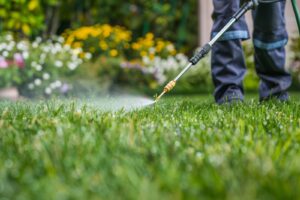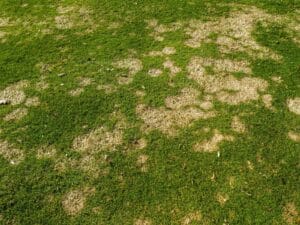A well-manicured lawn is a source of pride for homeowners, but dealing with unwanted lawn pests can be challenging.
Maintaining lawn health and beauty can sometimes feel like a full-time job, and it’s even more taxing when pests wreak havoc on your grass. These nuisances can turn your lush green carpet into a patchy, unhealthy mess without much warning.
Today, we’re exploring eight common lawn pests and providing effective strategies for eradicating them. Armed with the proper tools and methods, you’ll be ready to protect your lawn and restore it to its vibrant beauty.
1. Grubs
Grubs are among the most destructive lawn pests that pest control companies target. They are found just below the surface of a lawn or garden where they live in the soil. If the soil is exceptionally moist, they might emerge to feed on plant roots in your lawn or garden.
Grubs are c-shaped, white larvae of various scarab beetles. They feed on grass roots, causing brown patches and weakening the yard’s overall health. These brown patches are the most common sign of a grub problem, but here are some other ways you can tell that grubs are to blame:
- Turf that peels up easily from the soil
- Flocks of birds that descend on the damaged areas of grass
- Other critters paying a visit, such as raccoons, skunks, or moles
- Spongy spots that give underfoot when you walk over them
Grubs are most active in spring, late summer, and early fall, making those months the best windows for applying grub control. It’s best to apply grub treatment after aerating your lawn so the solution can more easily penetrate down to the grubs. Water your lawn immediately after and continue to monitor it carefully. Remember that some products can take up to a week to take their full effect.
For optimal results, we recommend enlisting the help of professional pest control services who can identify, treat, and eradicate the problem quickly and efficiently.
2. Chinch Bugs
Chinch bugs are another very common lawn pest that pest control companies aim to eradicate. These tiny insects suck sap from grass blades, leaving behind unsightly yellow or brown patches. Chinch bugs thrive in hot, dry areas, and it’s easy to mistake their destruction for drought effects. Watch for the following identifying features as you search for these pests during the summer months:
- Cinch bugs are tiny black insects with white wings
- They enjoy thick lawns with plenty of direct sunlight
- You’ll observe patches of yellow or brown dead grass
The best way to prevent chinch bugs is to aerate, dethatch, and fertilize your lawn regularly. In case of an infestation, you can treat your yard with insecticidal soap or neem oil. Keeping your lawn adequately watered can also help prevent infestations.

3. Mole Crickets
Mole crickets are burrowing insects that can cause significant lawn problems. They’re named for their mole-like behavior of tunneling through soil. While mole crickets are not true crickets, their shared similarities include their chirping sounds and long, spiky legs.
Brown patches on your lawn can also indicate the presence of mole crickets. They burrow through the soil and feed on insects, decaying plants, and grassroots, causing the withering and dying of plants.
Another sign of a mole cricket infestation is a sponge-like feeling across your yard. To prevent these pests from wreaking havoc, refrain from over-watering your yard. Moist gardens and soil make it easy for them to dig through and leave their destructive mark.
Apply granular or liquid insecticides labeled for mole cricket control to mitigate an infestation. You can also try mole cricket baits to attract and poison the pests. As always, if the problem persists, it’s time to call professional pest control services with access to more techniques and tools to eradicate the infestation for good.
4. Armyworms
Just like all other bugs and insects, worms come in many shapes and sizes. One of the most damaging species to lawns is the armyworm.
Armyworms are voracious caterpillars that can rapidly devastate any lawn they reach. They’re known for their tendency to move in large groups, resembling an army. They chew through grass blades, leaving bare, dead patches. Armyworms typically stay hidden from the sun during the day, making them the most active in the early morning, evening, and nighttime.
You can use the soap flush test method to identify these worms in your yard. Simply mix three tablespoons of liquid dish soap with one gallon of water. Pour the mixture into a small, 3’ x 3’ area of your yard and watch the action. The soap will agitate the worms’ skin, and they’ll emerge to the surface. Once you spot them, you’ll be ready to be able to begin treatment immediately.
Now that you’ve spotted the plump pests, it’s time to eradicate them. Apply pesticide specifically labeled to target armyworms across your yard. If you aren’t seeing success, a more concentrated treatment might be necessary through the expertise of pest control companies.
5. Moles and Voles
While moles and voles aren’t insects, they are still pests that can run amok and wreak havoc on your lawn. Like mole crickets, moles and voles tunnel through the grass, disturbing the soil. They damage grassroots and create unsightly mounds of soil and raised ridges across the landscape.
Moles can be a sign that other bugs are currently inhabiting your soil as well. Eliminating those other pests will help to deter the rodents elsewhere, too.
Patience and skill are necessary traits to have when targeting moles and voles. Traps are commonly used, but it can be a time-consuming endeavor. Maintaining a well-mowed lawn and using physical barriers can also deter these pests. Wire mesh around garden beds tends to work wonders at deterring pesky moles and voles.
6. Ants
If you’ve spent any time in the lawn care arena, you’re probably familiar with the nuisance of ants. Ants often build their nests in lawns, forming mounds and ridges all over the soil. Unlike the other pests we’ve covered, ants don’t directly feed on grass. Instead, they attract other pests like aphids as they disrupt the soil.
Ants can be challenging to get rid of for good. Here are a few at-home solutions you can try:
- Boiling water – If you can locate the nest, a healthy dose of boiling water can work wonders on an ant colony. Rake open the nest and carefully pour in the boiling water.
- Vinegar – Mix equal parts of vinegar and water with a few drops of liquid soap. Pour the mixture into the ant nest to kill and deter ants from your yard.
- Water – A good soaking is sometimes enough to eliminate pesky anthills from your lawn. Soak the nest for 15 to 30 minutes with water from a hose to saturate the soil and damage the ants’ home.
- Chemical ant insecticides – Over-the-counter ant killers can be a worthwhile solution to explore. Be sure to follow the label instructions and monitor the area for further ant activity.
Since ants are persistent, don’t hesitate to outsource pest control services for the most effective treatment.
7. Weeds
Weeds are another lawn pest that doesn’t fall under the “insect” category. Dandelions, clover, and crabgrass are all common enemies you might find in your yard. They suck the life out of your vibrant lawn, competing for nutrients, sunlight, and water. If weeds are currently your yard’s Achilles heel, explore the following techniques to kiss them goodbye:
- Once you have identified the weeds, select a proper herbicide. Pre-emergent herbicides tackle weed issues before germination, while post-emergent herbicides target already established weeds.
- Apply the treatment according to the directions on the label.
- Following the guidance on the label, determine how long you should expect to wait before noticing results.
- Rake and till the grass once the weeds start to die off and turn brown.
- Dethatch and aerate your lawn to make it more resilient to weeds in the future.
- Amend the soil and lay down seed or a new section of sod.
- Water the new areas in deep, infrequent cycles.
- Continue to maintain your lawn through fertilization, mowing, and watering.
8. Moss
Moss can signify poor lawn health. You’ll commonly find moss thriving in shaded or damp areas where grass struggles to grow. Many mosses have existed unchanged for millions of years, which is a hint of how tenacious they are.
To attack unwanted moss, focus your efforts during the spring and fall. First, rake up the moss with a bow or leaf rake. Apply a chemical moss killer that is specifically targeted to treat moss. Most herbicides used against weeds are not very effective against moss. Finally, you’ll need to remove thatch and aerate your lawn. If there are excessive shady areas housing the moss, consider opening up the area to allow more sunlight through.
Let Summit Lawn and Pest Control Help
Don’t let lawn pests get in the way of you enjoying your yard — instead, enlist the help of Summit Lawn and Pest Control for effective solutions.
Contact Summit Lawn and Pest Control today by calling us at 801-473-9926 for a personalized consultation, and let us provide you with tailored solutions to help you avoid pesky lawn pests.
Experience the peace of mind of entrusting your lawn care to experts committed to delivering exceptional results.







